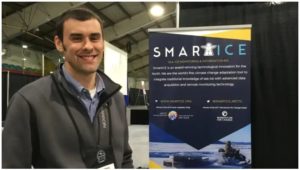Money will finance a production facility to make sensors that measure ice thickness

Cold hard cash is coming to Nain. And it’s going to the SmartICE project.
Labrador MP Yvonne Jones announced a $660,000 investment from the Atlantic Canada Opportunities Agency on Wednesday, while the province contributed $235,572 and the Nunatsiavut government supplied another $50,000.
The SmartICE project integrates traditional knowledge with advanced technology to provide insights into ice conditions.
The money will go toward a production facility in Nain to manufacture “Smart Buoy” prototypes, which measure sea-ice thickness.
“We have a small production area and we are hoping to be able to identify eight to 10 Inuit youth to start, and then we’ll hire a northern production lead that will guide them through the assembly process,” said Carolann Harding, the project’s business development director.
“If the timing works out as planned it will be October when assembly training takes place.”
Survey showed concern
In 2010, a survey was done with the Nunatsiavut government that found that 75 per cent of respondents were not confident in the ice.
“For community members it’s very important for them to be able to travel on the ice and to travel on the ice safely,” Harding said.
The survey said one in 12 people have gone through the ice.
– Carolann Harding
People were afraid to go out, as ice conditions became less predictable due to climate change.
“That same survey said one in 12 people have gone through the ice, which is significant,” she said.
The program — which is also being piloted in Pond Inlet, Nunavut — uses a combination of sea ice sensors and satellite imagery to map ice conditions in areas that community members use most. Due to a changing climate, those commonly used areas are less predictable and increasingly dangerous for travel.
“We want to make sure that this data that they get saves lives,” she said.
It’s a boon for Nain, and will also provide jobs in the region.
“It’s big for the community because it’s going to give the at-risk youth the opportunity to gain skills for employment and give them the opportunity to work and build a career,” said Tyler Spurrell, SmartICE technical operations lead.
“As well it’s going to make these sensors available to the communities, which is going to help with the ice monitoring.”


